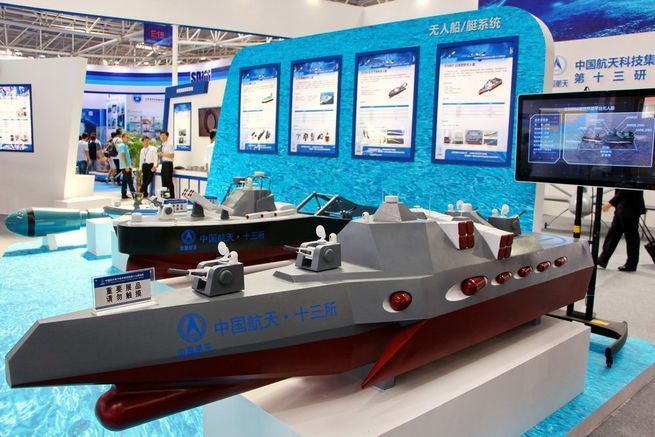
Swarm Race between World’s Navies Accelerates
A Chinese company specializing in Unmanned Surface Vehicles (USVs) tested a semi-autonomous “swarm” of 56 unmanned boats in the South China Sea on May 30th, according to defense blog War is Boring.
An important proof of concept mirroring U.S. efforts in USV swarm technology, the video may offer an important clue to the potential direction of Chinese strategy to come given the nation’s expertise in drone technology as well as the potential tactical advantages that cheap, overwhelming naval swarms might offer China against western navies.
The video shows the drone fleet participating in mass, synchronized formations, executing a variety of mesmerizing maneuvers including precise turns, randomized movements and even one scene in which the swarm emulates the shape of an aircraft carrier.
Above: Footage from the May 30 test of an autonomous USV swarm. Via Youtube.
Developed by Zhuhai Yunzhou Intelligence Technology Ltd. (OceanAlpha outside of China), the seaborne drones demonstrated in the test appear to be unarmed, but the video’s supporting graphics and the nature of the exercises showcased suggests the company is explicitly marketing the swarm boats directly for military applications. OceanAlpha USVs have already proven themselves capable of operating in demanding environments, such as a recent demonstration in which the stealthy M80B successfully completed survey work in the Antarctic.
Other private and state entities in China have also directly proposed USVs for military use, such as Sifang’s stealthy SeaFly craft capable of launching and recovering aerial drones, and an even more ambitious boat in development by the China Aerospace Science and Technology Corporation (CASC), the armed D3000 USV. The D3000 features a fearsome planned load-out of surface-to-air missiles, torpedoes, and 30mm Gatling guns similar to the U.S. Navy’s CIWS system.
As War is Boring notes, it would be a trivial step to arm drones such as OceanAlpha’s with weaponry. And even more important than the hardware on display is the boats’ underlying computational power and the complex interoperability required for successful execution of such large-scale coordination between the machines:
The expensive and difficult portion of a robotic swarm is the technology you can’t see — the networks and algorithms that allow machines to work together and avoid obstacles. The boats themselves are cheap. Once you figure out the mathematical problems, then it’s a simple matter of arming each of those small boats with rockets and missiles and sending them after a $1 billion cruiser. Like a swarm of mosquitoes, the cruiser can’t swat them all away before one draws blood.

Above: a model of the proposed D3000, an armed Chinese USV. Via Popular Science.
The prospect of a swarm of fully autonomous, fully expendable armed drones attacking an adversary with the speed, unpredictability, and numerical advantage of a “swarm of mosquitoes” is one likely to keep western naval commanders and strategists duly concerned about the battlefields of tomorrow, which will likely see increasingly robotic, increasingly self-governing, and increasingly terrifying systems employed. The U.S. has also been experimenting with seaborne drone swarms in past years—including the first large-scale test of the technology as well as a harbor defense exercise—leading to “some sort of weird swarm race” between the two superpowers.
WarisBoring.com notes that given China’s expertise with civilian and consumer drones in addition to the nation’s inability to feasibly match the U.S. in naval, air, or land power, drone swarms will likely present a tantalizing tactical advantage to China if its more conservative military leadership opts for such radical new technologies.
As described in the example above, mass swarms of small seacraft would give China an asymmetric advantage against the far larger and vastly more powerful vessels such as cruisers and aircraft carriers used by conventional navies such as the U.S. Navy, which has enjoyed uncontested dominance worldwide for more than half a century.







Leave A Comment